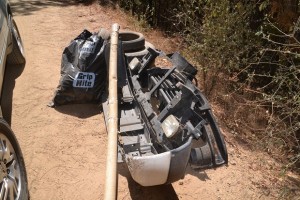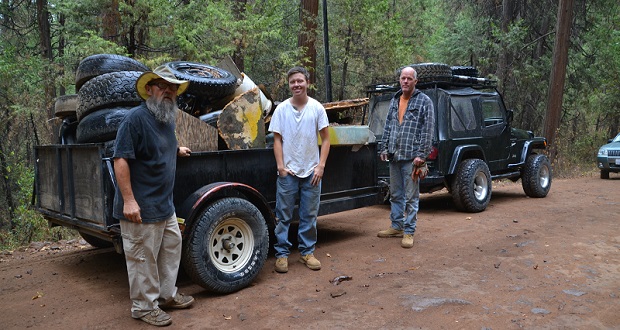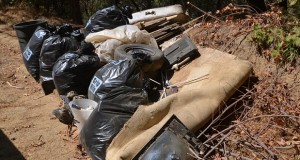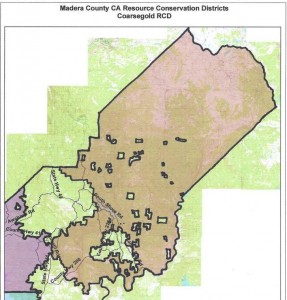MOUNTAIN AREA – You go for a walk in the forest hoping for a peaceful sojourn through tall trees, with picturesque pine-needle paths leading to a cedar-scented paradise where you contemplate the treasures of nature.
Instead, you’re tripping over old tires, making your way through broken-down refrigerators, busted air conditioners, televisions, and “just about anything you can think of.” You’ve stumbled on an illegal dump.
The foothills are spotted with more than a few such sites, where people wantonly deposit what they no longer want, from small bags of household trash to large old appliances, frequently on public land. Where one individual dumps once, others may follow, and soon a previously pristine location has become a near-disaster zone.
Now, five local sites where illegal dumping has proliferated have been cleaned up, thanks to the efforts of the Coarsegold Resource Conservation District (CRCD), local business All Right Recycling, and a $37,000 grant from CalRecycle.
Hundreds of hours have been put into the effort according to Keith Horton, owner of All Right Recyling based in Oakhurst.
“The areas we covered were the public areas on both sides of the fire road at the top of Road 420, the back side of Goat Mountain, Old Central Camp Road in North Fork, Forest Service Road 6S10Y up Highway 41 past Road 222, and Miami Trails,” explains Horton. “Miami Trails is the last site we’re doing, and we’re almost done.”
The recycling expert says Old Central Camp Road was the worst of all five locations, with the road adjacent to 420 close behind when it comes to the amount of trash dumped by the roadside and down the embankment.

Tires, metal pipe, the partial frame of a pick up truck are among the offenses of illegal trash dumps
All five sites are off main roads with parts only accessible by 4-wheel drive, and each site is not in just one location but rather scattered on hillsides, in brush and on roads.
They found more than two dozen tires, refrigerators, televisions, other large appliances and old electronics at the Road 420 site, alone. All the trash was either recycled or transported to the transfer station in North Fork. For all five locations, the All Right owner estimates they’ve transported about ten tons of trash to the dump.
“Every load we took into the transfer station was close to a ton, 2000 pounds, and we took at least ten loads, so that’s over 20,000 pounds,” he says. “We got wood, tires, everyday household trash, asphalt, couches, carpets, and more.”
Much of what the pros removed was small, including cans and bottles. Some of the detritus was massive, such as big pieces of steel, a partial pickup frame, and a large metal tank roughly four feet in diameter by eight feet long. All of that was recycled through Horton’s company.
“The hardest part was the tires,” he admits. “They will roll hundreds of feet downhill until they bounce off a few trees and finally fall to the side, coming to rest. Every time you’d go down the side of the hill to get a tire, you’d walk down and see another one, and then down a little farther, another. It seemed like it was endless.”
One of the dump sites was also home to exuberant, illegal target practice. The shooting range was littered with bullets, possibly lead, cans, and other makeshift targets in the landscape.
“When people have target practice, they blow whatever they’re aiming at into little bitty pieces,” Horton says, so the team raked every inch of the ground to clean it up. Horton is quick to give credit to his helpers, Devin Horton and Doug McIntyre, who were on the job nearly non-stop.
“Devin and Doug did so much work up and down the hills, they bent over and picked up every bubble gum wrapper, piece of gum, every little tiny thing,” says Keith of the labor that seems to come with a compulsion attached. “Many times when I was with them, they could not leave any little piece behind, no matter what. They were the ones going out of the way to stop the car and pick up something in the roadway. We were around Road 274 and someone had dropped a bag of pine needles, so we stopped. We saw a tire on Road 222, so we picked it up. It was good to see they really got into it, all the way down to the bubble gum wrappers.”
Some of the dump spots looked like contractors had been hired to haul large amounts of material out of sight: at one place there was an entire truckload of old carpet. It’s not all industrial-sized waste, though. Much of the accumulation starts out small-time.
“Sometimes it’s just three bags of household trash,” he says, and some dumpers just don’t know when to quit. “We had people unloading stuff overnight while we were cleaning up on Old Central Camp. We got there in the morning and there’s a mattress and box spring that someone had left while we were away.”
While Old Central Camp was the worst, the location off Road 420 in Coarsegold was the largest, where the crew spent about ten days on that site alone. First they drove the road, marked the spots where they’d seen trash dumps, then started pulling it up, going farther and farther down the hill, working only on Forest Service property. Horton says they found twice as much trash as they expected.
The funds to finance this major operation were provided by a grant awarded to the Coarsegold Resource Conservation District. Jay Seslowe is President of the CRCD Board of Directors, which consists of five members appointed by Madera County. Seslowe is the newest member, of less than a year, and was elected President by the Board about six months ago. The Raymond resident retired in 2013 as the Madera County Assistant Agricultural Commissioner.
“The CalRecycle grant is titled Farm and Ranch Solid Waste Cleanup and Abatement Grant,” Seslowe outlines, “and the impetus was that I have observed our local forests being compromised by the dumping of refrigerators, mattresses and household garbage. The Board members all live in the Madera County foothills and are interested in resource issues close to home. When I discovered the CalRecycle grant I contacted the USFS and found the person in charge of illegal dumping, Frannie Adams. She provided sites that needed to be cleaned up.”
The USFS and CRCD are both committed to forest health and the aesthetic beauty of the foothills, Seslowe adds.
“I worked closely with Keith Horton from All Right Recycling to determine the cost, time, equipment and other details required to clean up these sites. I was impressed by his integrity and interest in this project, which required one contractor. I submitted a grant proposal to CalRecycle and fortunately received the grant in the amount of $37,800.”
Keith Horton says the best part of the job has been the simply profound feeling of satisfaction he gets from having done good work where it’s really needed.
“It’s not just picking up trash, it’s restoration. It’s putting things back the way they’re supposed to be. There’s some energy in these mountains that you can really feel, and when one of these illegal dump sites is all cleaned up, and you walk around there, it feels better this way. It’s the way it’s supposed to be: clean and pristine, and I’ve felt really good about it every time we finished a cleanup site.”
The Coarsegold Resource Conservation District was founded in 1960. RCD began nationwide, following the creation of the federal Soil Conservation Service, now titled the Natural Resources Conservation Service, as a result of the 1930’s drought and dust bowl, according to Jay Seslowe.
The CRCD meets the fourth Thursday of the month at the North Fork Mill Site from 9 a.m. to noon. The public is not only invited, says the board president, but encouraged to attend the meetings. They’ve got some interesting projects in development.
“We are currently working with the Madera County Board of Supervisors, Environmental Health and County Building Department on a project to promote water conservation by the use of grey water,” Seslowe notes, explaining that two board presentations have already been given regarding the promotion of this technology.
“We will have FAQ’s, diagrams and resources to purchase grey water materials,” he says. “The CRCD has been involved with promoting grey water thru public outreach. We contacted Jill Yaeger, the Environmental Health Department Head. Ms. Yaeger was interested and the CRCD met with Tom Wheeler, Ms. Yaeger and Harry Hinton from the Building Department. This program is just getting off the ground.”






